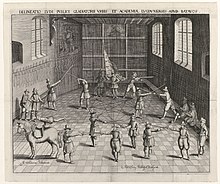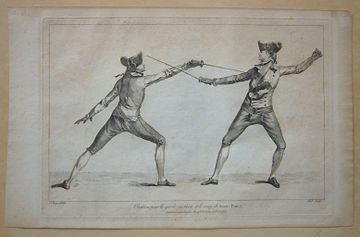History of fencing
[5][6] The English term fencing, in the sense of "the action or art of using the sword scientifically" (OED), dates to the late 16th century, when it denoted systems designed for the Renaissance rapier.
The first historical evidence from archaeology of a fencing contest was found on the wall of a temple within Egypt built at a time dated to approximately 1190 B.C.
[11] Homer's Iliad includes some of the earliest descriptions of combat with shield, sword and spear, usually between two heroes who pick one another for a duel.
Tomb frescoes from Paestum (4th century BC) show paired fighters with helmets, spears and shields, in a propitiatory funeral blood rite that anticipates gladiator games.
[citation needed] The earliest surviving treatise on sword fighting, stored at the Royal Armouries Museum in Leeds, England, dates from around 1300 AD and is from Germany.
It is known as I.33 and written in medieval Latin and Middle High German and deals with an advanced system of using the sword and buckler (smallest shield) together.
From 1400 onward, an increasing number of sword fighting treatises survived from across Europe, with the majority from the 15th century coming from Germany and Italy.
In this period these arts were largely reserved for the knighthood and the nobility – hence most treatises deal with knightly weapons such as the rondel dagger, longsword, spear, pollaxe and armoured fighting mounted and on foot.
Its precepts are based on reason, geometry, and tied to intellectual, philosophical, and moral ideals, incorporating various aspects of a well-rounded Renaissance humanist education, with a special focus on the writings of classical authors such as Aristotle, Euclid or Plato.
That older tradition, with roots in medieval times, was represented by the works of authors such as Jaime Pons [es; ca] (1474), Pedro de la Torre (1474) and Francisco Román (1532).
During the 16th century the Italian masters Agrippa, Capo ferro, di Grassi, Fabris, Giganti, Marozzo, and Viggiani wrote treatises which established Italy as the originator of modern fencing.
In 16th-century Germany compendia of older Fechtbücher techniques were produced, some of them printed; notably by Paulus Hector Mair (in the 1540s) and by Joachim Meyer (in the 1570s) and based on 14th-century teachings of the Liechtenauer tradition.
The Ecole Française d'Escrime founded in 1567 under Charles IX produced masters such as Henry de Sainct-Didier who introduced the French fencing terminology that remains in use today.
[19] Rapier gave rise to the first recognisable ancestor of modern foil: a training weapon with a narrow triangular blade and a flat "nail head" point.
A number of notable fencing masters from the late 16th century (Vincentio Saviolo, Rocco Bonetti, and William Joyner) ran schools in and around Blackfriars (then the main theatre district of London).
Light, smaller training weapons were developed on the basis of an existing template: narrow rectangular blade with a "nail head" at the end.
The foil was invented in France as a training weapon in the middle of the 18th century to practice fast and elegant thrust fencing.
Since fencing on thrust with a sharp point is quite dangerous, many students died from their lungs being pierced (Lungenfuchser), which made breathing difficult or impossible.
[citation needed] Masters and legendary fencing figures such as Giuseppe Radaelli, Louis Rondelle, Masaniello Parise, the Greco brothers, Aldo Nadi and his rival Lucien Gaudin were typical practitioners of this period.
The need to train swordsmen for combat in a nonlethal manner led fencing and swordsmanship to include a sport aspect from its beginnings, from before the medieval tournament right up to the modern age.
[27] There, he taught the aristocracy the fashionable art of swordsmanship which they had previously had to go the continent to learn, and also set up a riding school in the former rear garden of the house.
With the help of artist Gwyn Delin, he had an instruction book published in England in 1763 which had 25 engraved plates demonstrating classic positions from the old schools of fencing.
[28] He established the essential rules of posture and footwork that still govern modern sport fencing, although his attacking and parrying methods were still much different from current practice.
[33] The (so called) 'advanced weapons', Épée and Sabre deemed unsuitable or inappropriate for women, were not included in the Olympic program until late in the 20th century.
At the exhibition the invention proved an unalloyed success, and ought to be a boon both to competitors and judges—to the former on account of its certainty, and to the latter because it not only lightens their labours, but also frees them from any suspicion of partiality.
Starting with épée in 1933, side judges were replaced by the Laurent-Pagan electrical scoring apparatus,[36] with an audible tone and a red or green light indicating when a touch landed.
[40] For the first time Venetian fencing was detailed in some directions, it was described the properties of different parts of the blade, which were used in defense and offense.
This system is characterized by its use of longswords and the teachings of famous fencing masters like Johannes Liechtenauer, whose techniques and principles greatly influenced the martial traditions of the period.
Mensur is unique in its focus on ritualized dueling, where participants engage in controlled bouts designed to test their courage, endurance, and skill without the intent to harm.
He invented what came to be known as the "Patton Saber," in 1913, based on his studies with M. Clery L'Adjutant, reputed to be the finest Fencing Master in Europe at the time.








